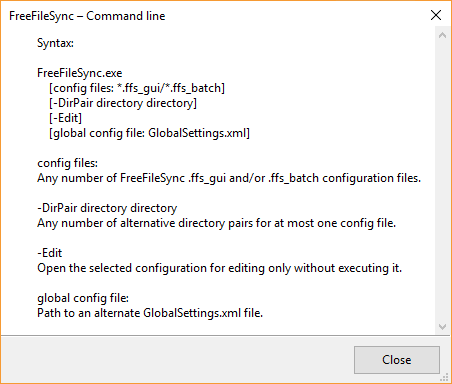

- FREEFILESYNC COMMAND LINE STOP PDF
- FREEFILESYNC COMMAND LINE STOP UPDATE
- FREEFILESYNC COMMAND LINE STOP PORTABLE
- FREEFILESYNC COMMAND LINE STOP WINDOWS
FREEFILESYNC COMMAND LINE STOP PORTABLE
Insert USB Disk (or any portable disk) into Work Computer.You can use GoodSync chains to synchronize files between Computers that are not connected to each other.įor instance, you can synchronize files between Work and Home computer using USB disk as an intermediary: GoodSync can perform Chained Syncing correctly. Chained SynchronizationĬhained syncing is a process when the contents of several folders (e.g., A, B, C and D) are synchronized by performing synchronization of pairs in sequence that results in propagation of changes (e.g., sync A and B, then B and C, then C and D results in changes in A propagating to folder B, then C, then D). GoodSync can handle this situation correctly too, it will propagate the older file version, if it detects that user made such replacement. The sophistication of GoodSync algorithm allows us to propagate deletions correctly through multiple chained folders.Īnother complication is that user may decide to replace newer version of the file with its older version. If you delete file on one side, GoodSync will propagate this deletion to the other side of sync job by deleting this file on the other side. Synchronization task would appear to be trivial (compare file modification files and let the newer file win) if it was not for deletions that need to be propagated. GoodSync One-Way Forced jobs enforce the backup scenario.Backup is one-way synchronization, that is, the changes that have been made on the left side are propagated to the right side but changes that have been made on the right side are not propagated to the left side.This is achieved by copying changes that have been made on the left side to the right side and changes that have been made on the right side are copied to the left side. Synchronization ensures that two folders remain in sync while user may change files on both sides.In this Section we discuss challenges that synchronization programs face and that GoodSync successfully addresses. Incrementally Backup all files from main hard drive to portable hard drive or another computer.Keep user files in sync on work and home computer via USB key.Synchronize folders on two computers not on the same network, via Internet.Synchronize notebook computer to desktop computer via local network.GoodSync can be used in these everyday scenarios: GoodSync synchronizes two or more folders with files, that is, GoodSync makes sure that folders and all files in them are the same by copying the new or updated files from the folder where they appeared to the folder where they are old or not present and by propagating deletions. Backup Files Incrementally: One Way Sync.Overview of how GoodSync works can be found here. If you are looking for an introduction to GoodSync, an Most users will be able to start syncing data immediately, without needing to reference this document. GoodSync provides friendly instructional information during installation. Who are utilizing the many powerful and customizable features of GoodSync.Īs this is a Reference Manual, it is not recommended for a new GoodSync user. This document is intended to serve as a guide for advanced GoodSync users
FREEFILESYNC COMMAND LINE STOP PDF
Printable Manual is available in PDF Preface
FREEFILESYNC COMMAND LINE STOP WINDOWS
See the progress and controls for new builds at Flathub buildbot ( beta branch).To be used with GoodSync ver 11.2.7 and higher.Īpplies to both GoodSync for Windows and GoodSync for Mac, unless noted otherwise.
FREEFILESYNC COMMAND LINE STOP UPDATE
# If there are no issues with beta, update the master branch # Create a new PR through GitHub: # After it is approved: Git push -u origin release- $ # Submit the pull request now (against the beta branch) through GitHub # After the PR is approved, merge it into the beta branch

Check your # 'flatpak list -app' output to make sure.įlatpak run //masterįlatpak remove //master Your dev version should be installed as the 'master' branch, so if you have the # stable version installed as well, you must distinguish them as shown below. The installation part is necessary, because due to extra-data approach (see # manifest), the actual FFS binary is downloaded and processed only during installation.įlatpak-builder builddir -force-clean -ccache -install -user

# Update shared modules cd shared-modules # Update the appdata: Create a new `` tag. # 2) For other modules (dependencies), check if there are newer releases available and update them. # Adjust the manifest: # 1) In the 'freefilesync' module, update `url`, `sha256` and `size`. # Create a new git branch for release REL (e.g.


 0 kommentar(er)
0 kommentar(er)
